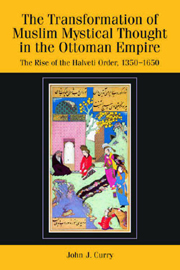 The Transformation of Muslim Mystical Thought in the Ottoman Empire
The Transformation of Muslim Mystical Thought in the Ottoman Empire Book contents
- Frontmatter
- Contents
- List of Maps and Figures
- Abbreviations for Frequently Cited Works in the Text
- Acknowledgments
- Note on Transliteration
- Map 1
- Map 2
- INTRODUCTION: ON THE STUDY OF OTTOMAN MYSTICAL TRADITIONS
- PART I THE RISE AND SPREAD OF THE HALVETİ ORDER FROM ITS ORIGINS THROUGH THE ELEVENTH/SEVENTEENTH CENTURY
- PART II THE EVOLUTION OF A HALVETİ SUB-BRANCH: THE LIFE AND CAREER OF ŞAcBÂN-I VELİ AND HIS FOLLOWERS IN THE KASTAMONU REGION
- INTRODUCTION
- 3 ECHOES OF A DISTANT PAST: ŞAcBÂN-I VELİ'S EARLY LIFE AND CONVERSION TO SUFISM
- 4 GENESIS OF A SUB-BRANCH: ŞAcBÂN-I VELİ'S STRUGGLES IN KASTAMONU
- 5 AN UNEVEN LEGACY: THE SUCCESSION TO ŞAcBÂN-I VELİ TO THE END OF THE TENTH/SIXTEENTH CENTURY
- PART III DEFENDING THE CULT OF SAINTS IN ELEVENTH/SEVENTEENTH-CENTURY KASTAMONU: TRANSFORMING THE ŞAcBÂNİYE ORDER UNDER cÖMER EL-FUɔÂDÎ
- CONCLUSION: WHAT CAN THE ŞAcBÂNİYE TEACH US ABOUT TRANSITIONS IN THE EARLY MODERN PERIOD OF WORLD HISTORY?
- Appendix I
- Appendix II
- Works Cited and Further Reading
- Index of Persons
- Index of Places
- Index of Subjects
5 - AN UNEVEN LEGACY: THE SUCCESSION TO ŞAcBÂN-I VELİ TO THE END OF THE TENTH/SIXTEENTH CENTURY
from PART II - THE EVOLUTION OF A HALVETİ SUB-BRANCH: THE LIFE AND CAREER OF ŞAcBÂN-I VELİ AND HIS FOLLOWERS IN THE KASTAMONU REGION
Published online by Cambridge University Press: 12 September 2012
- Frontmatter
- Contents
- List of Maps and Figures
- Abbreviations for Frequently Cited Works in the Text
- Acknowledgments
- Note on Transliteration
- Map 1
- Map 2
- INTRODUCTION: ON THE STUDY OF OTTOMAN MYSTICAL TRADITIONS
- PART I THE RISE AND SPREAD OF THE HALVETİ ORDER FROM ITS ORIGINS THROUGH THE ELEVENTH/SEVENTEENTH CENTURY
- PART II THE EVOLUTION OF A HALVETİ SUB-BRANCH: THE LIFE AND CAREER OF ŞAcBÂN-I VELİ AND HIS FOLLOWERS IN THE KASTAMONU REGION
- INTRODUCTION
- 3 ECHOES OF A DISTANT PAST: ŞAcBÂN-I VELİ'S EARLY LIFE AND CONVERSION TO SUFISM
- 4 GENESIS OF A SUB-BRANCH: ŞAcBÂN-I VELİ'S STRUGGLES IN KASTAMONU
- 5 AN UNEVEN LEGACY: THE SUCCESSION TO ŞAcBÂN-I VELİ TO THE END OF THE TENTH/SIXTEENTH CENTURY
- PART III DEFENDING THE CULT OF SAINTS IN ELEVENTH/SEVENTEENTH-CENTURY KASTAMONU: TRANSFORMING THE ŞAcBÂNİYE ORDER UNDER cÖMER EL-FUɔÂDÎ
- CONCLUSION: WHAT CAN THE ŞAcBÂNİYE TEACH US ABOUT TRANSITIONS IN THE EARLY MODERN PERIOD OF WORLD HISTORY?
- Appendix I
- Appendix II
- Works Cited and Further Reading
- Index of Persons
- Index of Places
- Index of Subjects
Summary
For the population of the Ottoman Empire, the death of the long lived Sultan Süleymân, the only ruler most had known, ushered in a period of growing instability. The impending arrival of the Muslim millennium in 1000/1591, and the political and economic tensions unleashed by the Ottoman Empire's growing pains only added to the social and religious tensions of the age. For the nascent following of the Şacbâniye order in Kastamonu, the uncertainty was doubly pronounced given the illness and death of Şacbân-ı Veli shortly after Süleymân. Despite these challenges, the core membership of the order rallied around its leaders and principles, and a disparate group of several successors to Şacbân's legacy emerged who succeeded in maintaining his legacy. These figures had more direct connections with Şacbân's hagiographer, cÖmer el-Fuɔâdî, and their relationships with him developed on a much more personal level than Fuɔâdî could claim with regard to Şacbân himself. Still, a careful reading of Fuɔâdî's narrative of the post-Şacbân era suggests that by the time he acceded to the leadership of the Şacbâniye in 1012/1604, the order's development still remained uneven in character, and the legacy of its founder was under threat as it receded into an increasingly distant past.
- Type
- Chapter
- Information
- The Transformation of Muslim Mystical Thought in the Ottoman EmpireThe Rise of the Halveti Order, 1350–1650, pp. 156 - 194Publisher: Edinburgh University PressPrint publication year: 2010


